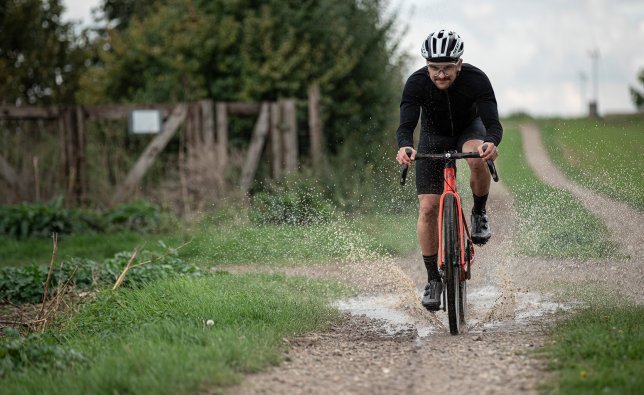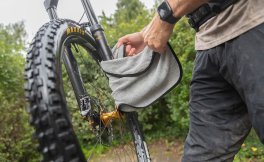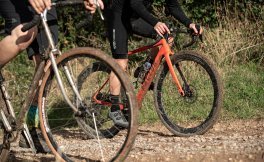
How to Chain Wax: Easy bike chain waxing guide
Chain wax ensures a clean, quiet, and highly durable bicycle chain. Whether it's hot wax or drip wax - we'll show you how to properly wax your bike chain.
What is the best way to clean your bike after a ride in the mud or rain? Here you will find practical tips and recommendations.
Muddy corners, the rain whips in your face, dirt pelts against the down tube: Autumn is coming! Sooner or later it comes, the mudslide when mountain biking or riding a gravel bike or the washing machine spin cycle on the road bike. In contrast to riding in summer, this requires some more follow-up procedures, not only for the human but also for machine. We explain here how to clean your bike gently and efficiently and which tools are perfect for the job.
When you come home after a hard ride in the rain or mud, you usually want to go straight to the couch. If possible, however, you should not wait until all the dirt on your bike has dried. Not only is it much more difficult to remove then, but the paint and other surfaces also suffer if the dirt is rubbed off or rubbed away. So it's better not to procrastinate too long and make your bike presentable again before you even take your own shower. How exactly you should proceed depends on whether your bike has only caught a few splashes of dirt or a complete mud pack. Less is sometimes more, and you should not necessarily always hose your entire bike down, but only when it is really necessary. Mechanical components love grease and oil and do not like water, but they like dirt, sand and dust even less. This means that light soiling can also be wiped off with a damp cloth and you don't always have to give your bike a whole shower.

But let's assume the worst-case scenario: The model and colour of your bike are no longer recognisable, it rustles and creaks all over the place, so your bike gets a good hosing down. The best way to do this is to use the moderate jet from your garden hose or a portable device and NOT the pressure washer at the petrol station. Such high pressure can easily penetrate the seals and make the water go where it does not belong at all: inside ball bearings, plain bearings or, for example, under the seals of the fork and seatpost. To achieve the best possible result, we recommend using a bicycle cleaning product, as this cleans even more thoroughly than pure water. It is sprayed on the entire bicycle and is compatible with all components. After leaving it on for a few minutes, the cleaner is rinsed off together with the dirt and the bike looks almost like new again. In addition to their function, it is important to us to mention at this point that our TONIQ products are biodegradable and the oils are 100% plant-based. These attributes in particular are by no means a matter of course when it comes to cleaning agents, and so we saw the need for a sustainable alternative from our own company. However, the bike cleaner alone does not always remove all the dirt - the best results are achieved with a soft brush; never use a coarse scrubbing brush or similar from your shoe cabinet! A smaller brush is particularly suitable for hard-to-reach areas, while larger surfaces, such as the tubes of the main frame, rims and tyres, are better treated with a larger brush. Then, after rinsing, we wipe the bike dry with a microfibre cloth.



At first glance, you could almost return the bike to the shop, but we don't just want it to look good, we want it to function perfectly. The best way to do this is to use a repair stand. We start with the drivetrain: After a long ride in the wet, the chain is usually covered with a mixture of chain oil and dirt - technical term: gunk -, which is also difficult to remove with water or a bicycle cleaner. To do this, simply use an old, lint-free cloth and pull the chain through a few full turns. If the chain is particularly dirty, spray a degreaser onto the cloth. To clean the rear derailleur pulleys and chainrings, a medium-sized flat-head screwdriver held to the side of the rotating pulley or chainring is well suited to "scrape off" the above-mentioned gunk. If the cassette is very dirty between the sprockets, you can work on it with a sprocket brush; these often have smaller brushes integrated. Once the drivetrain is cleaned and dry, the chain should be lubricated to restore smoothness and corrosion protection. We use a classic chain oil for this, but many riders also swear by wax. In our opinion, oil lubricates longer, while wax attracts much less dirt. A matter of opinion. It is very important that you wipe off the chain with a dry cloth a few minutes after re-lubrication to remove excess oil, which would attract new dirt. The chain is now lubricated on the inside, where the inner rollers turn, but on the outside it is almost dry and oil-free.
On a mountain bike, you usually have a suspension fork and nowadays very often a dropper post, with full-suspension bikes also a rear shock for the rear triangle. The need to maintain these components is often underestimated. When dipping the fork or the rear shock or lowering the dropper post, a little dust and dirt is pressed against the wipers every time. In addition to regular servicing of the suspension elements, it is therefore essential to clean the dust wipers and the stanchion tubes or the rear shock’s piston rod after every ride. This is best done with a soft, clean cloth. Once dust gets under the seals, it does not only affect the performance of the suspension elements (or the seatpost), but there is also the risk that the sliding surfaces of the stanchion tubes will be "sanded", which can lead to total failure in the long run. To keep the dust wipers supple, we sometimes smear 2-3 drops of fork oil on them with our finger while the bike is stationary. This way, they do not become brittle so quickly, which increases their service life. Important: Wipe dry again before the next ride so that dust is not attracted unnecessarily.
Finally, you can treat your bike with a protective care spray to protect it from the elements. Water and dirt then roll off better, rust-prone parts such as bolt heads are protected from corrosion and the bike gets a shiny finish. But be careful: Don't go completely overboard with the cleaning, otherwise your bike will be too good afterwards to ride it in the mud again! And even though it requires more maintenance, the wet season has its charm. Personally, I enjoy bike maintenance enormously because the optimal functioning of the components, some of which are quite expensive, is important to me, and for me this also expresses my appreciation for one of the most beautiful inventions of mankind. So have fun getting your bike dirty and clean again.